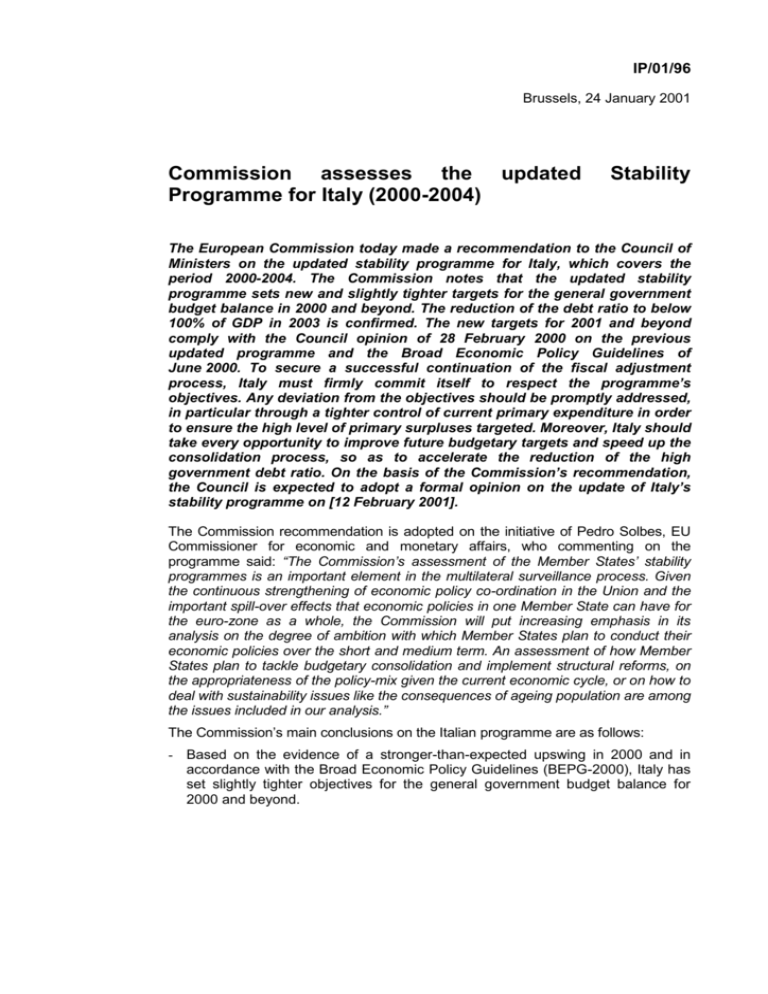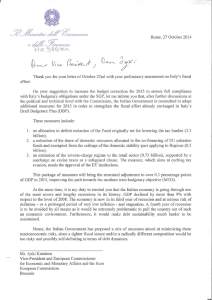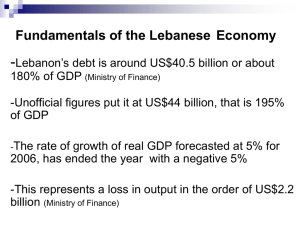DOC - Europa
advertisement

IP/01/96 Brussels, 24 January 2001 Commission assesses the updated Programme for Italy (2000-2004) Stability The European Commission today made a recommendation to the Council of Ministers on the updated stability programme for Italy, which covers the period 2000-2004. The Commission notes that the updated stability programme sets new and slightly tighter targets for the general government budget balance in 2000 and beyond. The reduction of the debt ratio to below 100% of GDP in 2003 is confirmed. The new targets for 2001 and beyond comply with the Council opinion of 28 February 2000 on the previous updated programme and the Broad Economic Policy Guidelines of June 2000. To secure a successful continuation of the fiscal adjustment process, Italy must firmly commit itself to respect the programme’s objectives. Any deviation from the objectives should be promptly addressed, in particular through a tighter control of current primary expenditure in order to ensure the high level of primary surpluses targeted. Moreover, Italy should take every opportunity to improve future budgetary targets and speed up the consolidation process, so as to accelerate the reduction of the high government debt ratio. On the basis of the Commission’s recommendation, the Council is expected to adopt a formal opinion on the update of Italy’s stability programme on [12 February 2001]. The Commission recommendation is adopted on the initiative of Pedro Solbes, EU Commissioner for economic and monetary affairs, who commenting on the programme said: “The Commission’s assessment of the Member States’ stability programmes is an important element in the multilateral surveillance process. Given the continuous strengthening of economic policy co-ordination in the Union and the important spill-over effects that economic policies in one Member State can have for the euro-zone as a whole, the Commission will put increasing emphasis in its analysis on the degree of ambition with which Member States plan to conduct their economic policies over the short and medium term. An assessment of how Member States plan to tackle budgetary consolidation and implement structural reforms, on the appropriateness of the policy-mix given the current economic cycle, or on how to deal with sustainability issues like the consequences of ageing population are among the issues included in our analysis.” The Commission’s main conclusions on the Italian programme are as follows: - Based on the evidence of a stronger-than-expected upswing in 2000 and in accordance with the Broad Economic Policy Guidelines (BEPG-2000), Italy has set slightly tighter objectives for the general government budget balance for 2000 and beyond. The new objectives are equal to deficits of 1.3% of GDP in 2000 (down from the previous 1.5%), 0.8% of GDP in 2001 and 0.5% of GDP in 2002, a balance in 2003 and a surplus of 0.3% of GDP in 2004. Although the government debt ratio for 200 was revised to 112.1% of GDP from 111.7% of GDP in the previous update, the reduction of the government debt ratio to below 100% of GDP in 2003 is confirmed. The budgetary targets for 2001 and beyond comply with the Council opinion of 28 February 2000 and the BEPG 2000, but because of the still high debt to GDP ratio and the future challenges to the long-term sustainability of public finances from ageing population, the Commission considers that Italy’s revised fiscal targets could have been more ambitious. - The budgetary strategy, a continuation of the policy outlined in the initial stability programme, aims at consolidating public finances by keeping a high primary surplus and reducing current expenditure as a percentage of GDP, in parallel with some easing of the tax burden and an expansion of public investment. In line with this strategy, the structural tax and social security contribution reductions, introduced with the Financial Law for 2001, are assumed to be backed by higher than expected revenues accruing from a broader tax base and more effective tax collection. - The analysis of the underlying budgetary position in the update shows that Italy would continue to be in conformity with the Stability and Growth Pact. The budgetary targets, if respected, entail a further improvement in the underlying budgetary position from a cyclically-adjusted deficit of 0.5% of GDP in 2001 to a balanced position in 2004. - The assessment of the fiscal policy framework presented in the updated stability programme suggests risks exist that the budgetary objectives may not be fully met. As regards the year 2000, there are indications that the general government deficit may end up closer to the original objective of 1.5% of GDP than to the new objective and would then not be fully in compliance with the recommendations of last year’s Council Opinion and of the Broad Economic Policy Guidelines of June 2000. For 2001 and beyond, concerns remain that the higher trend of tax receipts underpinning the tax and contribution cuts may not be entirely structural. Moreover, the corrective measures introduced with the Financial Law for 2001 as well as the provisions strengthening the domestic stability pact could be less effective than planned. Finally, the macroeconomic scenario of the updated programme assumes an acceleration in GDP growth, which may be optimistic in the light of recent developments in the external environment. - Italy is urged to firmly commit itself to respect the programme’s objectives. Any deviation from the planned outcomes should be promptly addressed and necessary corrective measures taken. Primary surpluses should remain at the high levels announced in the programme, through a tight control of current primary expenditure. The reduction in the ratio of current primary expenditure to GDP should be accompanied by a more comprehensive rationalisation of public spending, aimed at improving the supply-side conditions of the economy. Tax cuts should be matched by offsetting expenditure cuts and should be undertaken only after better-than-planned budgetary results have been achieved. Moreover, Italy should take every opportunity to improve future budgetary targets and speed up the consolidation process, in order to accelerate the reduction of the high government debt ratio. 2 - Italy has not made significant progress in meeting the medium-term structural challenges to public finances from pension and other age-related budgetary expenditures. Although the Financial Law for 2001 includes some isolated measures on pensions, a wider approach should be adopted. The reassessment of the pension system should take place within the framework of a broader overhaul of the Italian welfare system. In any case, the review of the parameters of the pension system scheduled to take place later this year should not be postponed. The Stability and Growth Pact adopted by the Amsterdam European Council in June 1997 requires countries participating in the Euro-zone to present updates of the stability programmes annually to the Council and to the Commission. These programmes provide information on how countries intend to meet the objectives of the Pact and in particular the medium-term goal of a budget close to balance or in surplus. Key Figures of the updated stability programme of Italy: 2000 2001 2002 2003 2004 Real GDP growth rate (annual % change) 2.8 2.9 3.1 3.1 3.1 General government balance (% of GDP) -1.31 -0.8 -0.5 0.0 0.3 Government debt (% of GDP) 112.1 106.6 103.5 99.6 94.9 Inflation (private consumption deflator, 2.8 annual % change) 2.3 1.5 1.5 Employment (annual % change) 1.1 1: 1.2 1.5 1.1 1.1 1.1 The figure excludes the impact of the proceeds from the auction of UMTS licences. If recorded in 2000, in compliance with the decision of Eurostat n.81/2000, they would translate into an official deficit ratio of 0.1% of GDP. 3









